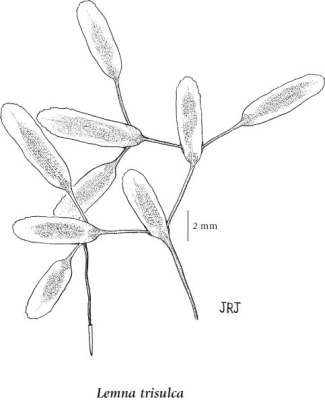Lemna trisulca L.
ivy-leaved duckweed (star duckweed)
Lemnaceae
Introduction to Vascular Plants
ivy-leaved duckweed (star duckweed)
Lemnaceae
Introduction to Vascular Plants
Species Information
General:
Fronds annual, usually submersed, oblong to lanceolate, 6-12 mm long, long-stalked, remaining attached in a zig-zag chain, obscurely 3-nerved, the young plants produced from pouches on either side near the junction of the stalk and the plant body.
Illustration

If more than one illustration is available for a species (e.g., separate illustrations were provided for two subspecies) then links to the separate images will be provided below. Note that individual subspecies or varietal illustrations are not always available.
Illustration Source: The Illustrated Flora of British Columbia
USDA Species Characteristics
Flower Colour:
Green
Blooming Period:
Late Spring
Fruit/Seed characteristics:
Colour: Green
Present over the Summer
Source: The USDA
Ecology
Ecological Framework for Lemna trisulca
The table below shows the species-specific information calculated from
original data (BEC database) provided by the BC Ministry of Forests and Range.
(Updated August, 2013)
The table below shows the species-specific information calculated from
original data (BEC database) provided by the BC Ministry of Forests and Range.
(Updated August, 2013)
| Site Information |
Value / Class |
||
|
Avg |
Min |
Max |
|
| Elevation
(metres) |
1054 | 560 | 1204 |
| Slope
Gradient (%) |
0 | 0 | 0 |
|
Aspect (degrees) |
0 | ||
| Soil
Moisture Regime (SMR) [0 - very xeric; 4 - mesic; 8 - hydric] |
7 | 7 | 8 |
| Modal
Nutrient Regime
Class |
E | ||
| #
of field plots species was recorded in: |
18 | ||
| Modal
BEC Zone Class |
SBPS | ||
|
All BEC Zones (# of stations/zone) species was recorded in |
BG(1), IDF(4), SBPS(13) | ||
|
Source:
Klinkenberg 2013
|
|||
Habitat and Range
Ponds and slow-moving streams in the lowland, steppe and montane zones; frequent throughout BC south of 56degreeN, absent on the Queen Charlotte Islands and the mainland coast, infrequent elsewhere in BC east of the Coast-Cascade mountains and S of 55degreeN; circumpolar, N to AK, YT and NT, E to NB and NS and S to VA, AL, AR, TX, NM, AZ, CA and MX; Eurasia, S America.Status Information
Taxonomic Keys
1. Fronds oblong to lanceolate, 6-12 mm long, long-stalked, remaining attached in a zig-zag chain, usually submersed..................Lemna trisulca
1. Fronds elliptic, rounded or broadly egg-shaped, 2-6 mm long, unstalked, quickly becoming detached, floating on the surface...............Lemna minor |